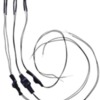Interesting topic good coverage.
I have a fleet of Williams engines great pullers run well.
As I run them mostly constantly with long trains at shows the start stop is not an issue for speed just get them rolling set speed and leave them running most of the day for the odd show.
Interesting in a recent magazine review of the new Williams engines on speed with low volts and sound system a constant engine sound. I would be uncomfortable with a constant engine sound running all day would get annoying with no way to shut it off.
I think perhaps if Williams would just re-gear all its engines so they run slower overall they would be better engines for switching starting and stopping more smoothly and the new sound system would be more useful being able to run a range of sounds.
As for the Evans designs LED sets they are great have converted every Williams engine to use them.
They stay about the same brightness from the train just moving to warp speed no matter the voltage and as noted can run on AC or DC with nothing added.
They have green red white warm and cold white yellow flickering fires etc.
I have bought and used lots of bulbs the flickering fire set for the Hobo fire on the Polar express roof works well.
On the engines I use what ever bulb will fit the headlights very nice bright beam.
For the # boards or marker lights the smaller bulbs work well.
If you take a small bulb and point it back into the cab and surround it with tinfoil this works best for lighting the # boards.
The small bulbs can fit some of the marker lights.
Also work well for the tail ends of passenger trains marker lights etc.
Again if we all wrote Williams Bachmann and said please gear your engines lower the perhaps we would get better sounding and running engines from the lower voltages. They would be better at starting with heavy loads have more torque.
Few Williams engines would even stay on the tracks with a full load.
though they would be great for Trains nascar racing!







